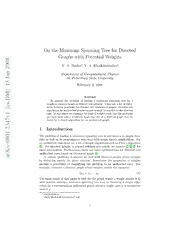
On the Minimum Spanning Tree for Directed Graphs with Potential Weights PDF
Preview On the Minimum Spanning Tree for Directed Graphs with Potential Weights
On the Minimum Spanning Tree for Directed Graphs with Potential Weights 8 0 0 V. A. Buslov∗, V. A. Khudobakhshov† 2 n Department of Computational Physics a J St.-Petersburg State University 5 1 February 2, 2008 ] M Abstract D In general the problem of finding a miminum spanning tree for a . s weighted directedgraphisdifficultbutsolvable. Therearealot ofdiffer- c encesbetweenproblemsfordirectedandundirectedgraphs,thereforethe [ algorithmsforundirectedgraphscannotusuallybeappliedtothedirected 1 case. Inthispaperweexaminethekindofweightssuchthattheproblems v are equivalent and a minimum spanning tree of a directed graph may be 7 found bya simple algorithm for an undirected graph. 4 3 2 1 Introduction . 1 0 The problem of finding a minimum spanning tree is well known to graph theo- 8 rists as well as to programmers who deal with graph theory applications. For 0 anundirectedcasetherearealotofsimplealgorithmssuchasPrim’salgorithm : v [5]. For directed graphs, a general solution also exists, see papers [1, 2, 3] for i X more information. Furthermore, there are some optimizations for directed and r undirected cases based on Fibonacci heaps [4]. a In certain problems in physics we deal with directed graphs whose weights by definition satisfy the given relation. Sometimes the properties of weights provide a possibility of simplifying the problem to an undirected case. For example, consider a directed graph whose weights satisfy the equation Q =ϕ −ϕ . (1) ij ij ii The main result of this paper is that for the graph whose a weight matrix is Q with positive entries a minimum spanning tree may be found by a simple algo- rithmforacorrespondingundirectedgraphwhoseaweightmatrixissymmetric matrix ϕ. ∗[email protected] †[email protected] 1 One can think about the weight ϕ as a height of a potential barrier which ij has to be surmounted in order to get to point i from point j. From this point of view ϕ is a local minimum of a potential well. So weights which satisfy ii Equation (1) will be called potential. 2 Definitions Depending on the problem, directed trees may be defined in two ways. Usually itissupposedthatin-degreeid(v)≤1 forallverticesv. Howeverwe definetree such that out-degree od(v) ≤ 1 and od(v) = 1 iff v is the root. We will denote G(V,E,ω) for an undirected graph where V is a vertex set, E is an edge set and ω is a weight matrix corresponding to the edge set. Clearly ω is always symmetric. Inthecaseofadirectedgraphwewillusethe samenotationexcept a prime to denote a directed graph and we will use A instead of E in order to note that in the directed case we will have an arc set. Also in the undirected case the weight matrix is not neccessary symmetric. 3 Minimum Spanning Trees SupposewehaveanundirectedgraphG(V,E,ϕ),whereϕisasymmetricmatrix whose diagonal entries are not neccessary equal to zero, but inequations ϕ < ii ϕ andϕ <ϕ holdforallk 6=i. ForeveryGwecandefineadirectedgraph ik ii ki G′(V,A,Q) where Q is a weight matrix which satisfies Equation (1). We must find a tree T which minimizes the following expression w(T)= X Qij. (2) (i,j)∈T ThistreeiscalledaminimumspanningtreefortheweighteddirectedgraphG′. The minimum spanning tree for undirected graphG is defined in a similar way. For this class of weighted directed graphs the following proposition can be posed. Proposition1. Aminimumspanningtreeofadirectedgraph G′ coincides with a minimum spanning tree for an undirected graph G with a root in vertex k for which ϕ is minimum. kk Proof. Theminumumfor(2)canbewritten,accordingforQweightsproperties in following form: min w(T)= min X (ϕij −ϕii). T⊂G′ T⊂G′ (i,j)∈T Allowingforthe factsthatthe numberofarcsinspanningtree T equals|V|−1 and the off-diagonal entries do not depend on diagonal ones, the minimum of 2 the previous expression equals min X ϕij −maxXϕii. T⊂G′ k (i,j)∈T i6=k It is clear that if ϕ = 0 for all i then G′ changes1 to G. Therefore the first ii summand in the previous expression equals to the weight of the corresponding a minumum spanning tree of the undirected graph G. min X ϕij −maxXϕii T⊂G k {i,j}∈T i6=k It follows |V| min X ϕij −Xϕii+minϕkk T⊂G k {i,j}∈T i=1 As a result, the minimum spanning tree of G′ can be given from the minimum spanningtreeofGbyfixingarootinvertexkwithaminimumvalueofϕ . kk 4 Conclusion and Future Work In the previous section it is shown that algorithms for undirected graphs can be applied to a directed case if weights of a directed graph have certain special properties. In the future we plan to get a solution for a more difficult problem, finding the minimum spanning forest for graphs whose weights are potential. References [1] F. Bock. An algorithm to construct a minimum directed spanning tree in a directed network. In Developments in Operations Research, pages 29–44, New York, 1971.Gordon and Breach. [2] Y. J. Chu and T. H. Liu. On the shortest arborescenceof a directed graph. Sci. Sin., Ser. A, 14:1396–1400,1965. [3] J. Edmonds. Optimum branchings. J. Res. Nat. Bur. Standards, B71:233– 240, 1967. [4] Harold N. Gabow, Zvi Galil, Thomas H. Spencer, and Robert E. Tarjan. Efficient algorithms for finding minimum spanning trees in undirected and directed graphs. Combinatorica, 6:109–122,1986. [5] R. C. Prim. Shortest connection networks and some generalizations. Bell Systems Technology Journal, 36:1389–1401,1957. 1 Inthiscasewecanchangetheorderedpair(i,j)toa2-elementssubset{i,j}. 3
